
Making a Living
In his first comedy, made from January 5-9, 1914, Chaplin has not adopted his famous character or costume. His character is a dubious dandy who aspires to be a newspaper reporter; he sports a top hat, frock coat, monocle, and drooping moustache. (He later adopted a variation of this costume for Professor Bosco—a flea-circus proprietor—in his abandoned First National comedy The Professor). The character and costume also harkens back to Chaplin’s time with Fred Karno. Indeed, he infused the part with bits of business he had learned from Karno. Nevertheless, director Henry Lehrman (who plays the rival), cut Chaplin’s best comedy bits. ‘Henry Lehrman confessed years later that he had deliberately done it,’ Chaplin wrote in his autobiography, ‘because, as he put it, he thought I knew too much.’
Finished and shipped: January 14, 1914
Released: February 2, 1914
Scenario: Reed Heustis
Producer: Mack Sennett
Director: Henry Lehrman
Length: One reel
By Jeffrey Vance, adapted from his book Chaplin: Genius of the Cinema (New York, 2003) (c) 2009 Roy Export SAS

Kid Auto Races at Venice
Kid Auto Races at Venice, Cal. is enormously important as the comedy in which audiences first saw Chaplin’s Tramp character. It is also invaluable as it affords an opportunity to examine the reactions of Chaplin’s first audience—the spectators at the car race—to the comic antics of the Tramp. Kid Auto Races at Venice, Cal. was filmed at the second annual ‘Pushmobile Parade,’ a children’s car race, held on Sunday January 11, 1914 in Venice, California. The improvised film (allegedly filmed in a mere forty-five minutes) has as its comic situation the Tramp managing to get in the way of the motion picture cameraman who is attempting to film the event. At first the spectators do not know what to make of the funny little man. Is he really a nuisance? As the action continues, their puzzlement changes to genuine amusement. Unlike other screen comedians, Chaplin immediately positions himself as one with his audience.
A split-reel film (running 500 feet or less), Kid Auto Races at Venice, Cal. was originally released with the educational film Olives and their Oil.
Finished and shipped: January 17, 1914
Released: February 7, 1914
Scenario: Reed Heustis
Producer: Mack Sennett
Director: Henry Lehrman
Length: Split reel
By Jeffrey Vance, adapted from his book Chaplin: Genius of the Cinema (New York, 2003) (c) 2009 Roy Export SAS
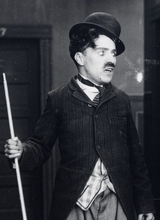
Mabel's Strange Predicament
This is the first film in which Chaplin wore the Tramp costume (Kid Auto Races at Venice, Cal. was photographed after Chaplin had filmed his first scene in Mabel’s Strange Predicament and—because of its split-reel length—was finished and shipped for distribution before Mabel’s Strange Predicament). This assertion is confirmed not only by Chaplin’s memories, but also by the recollections of Hans Koenekamp (the film’s cinematographer) and Chester Conklin (who plays the husband). Chaplin’s character is described as ‘a drunken masher.’ In his very first scene, Chaplin was savvy enough to create so much comic material that it would be difficult to cut in editing. (Sennett had been reluctant to let most shots run more than ten feet. Chaplin’s opening shot ran approximately 75 feet.) Chaplin asked Sennett, ‘If it’s funny, does it really matter?’ Sennett agreed with Chaplin. Mabel’s Strange Predicament was not only Chaplin’s first film as the Tramp, but also his first effort to create his own type of film comedy.
Mabel’s Strange Predicament is the first of several Keystone comedies in which Chaplin reprises in some form the comic drunk he had perfected for Fred Karno. Mack Sennett was surprised by Chaplin’s youth upon their first meeting as he expected him to be much older. This prompted Chaplin to adopt the disguising moustache. It is worth noting that Chaplin also chose to apply age makeup—accentuating his nasal-labial fold lines—in an effort to appear older. It would not be repeated beyond this one film. The film’s hotel mixup situation—with Mabel Normand locked out of her room dressed only in pajamas—was engagingly provocative for the time and anticipates similar situations Chaplin constructed for Caught in the Rain and A Night Out (1915).
Finished and shipped: January 20, 1914
Released: February 9, 1914
Scenario: Reed Heustis
Producer: Mack Sennett
Director: Mabel Normand
Length: One reel
By Jeffrey Vance, adapted from his book Chaplin: Genius of the Cinema (New York, 2003) (c) 2009 Roy Export SAS
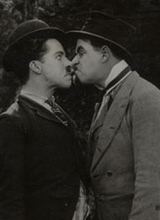
Between Showers
Between Showers was inspired by a series of torrential rainstorms that soaked Los Angeles. (The large roadside puddle used in the comedy suggests the severity of these rains). As much a Chaplin comedy as a vehicle for Ford Sterling, the comic situation for this violent, improvised film involves a display of gallantry toward a young woman (Emma Clifton) and the ownership of an umbrella. The policeman (Chester Conklin), from whom the umbrella was originally stolen, reclaims his prized item at the film’s conclusion. This was the last Chaplin film directed by Henry Lehrman, with whom Chaplin had a contentious relationship. Already in evidence are several of the Tramp’s distinctive characteristics: the way he rounds a corner (making a sharp turn and skidding, holding one foot out and balancing on the other foot), his iconoclastic nose-thumbing, the shrug of the shoulders, and covering his mouth with his hand when he laughs.
Finished and shipped: February 7, 1914
Released: February 28, 1914
Scenario: Unknown
Producer: Mack Sennett
Director: Henry Lehrman
Length: One reel
By Jeffrey Vance, adapted from his book Chaplin: Genius of the Cinema (New York, 2003) (c) 2009 Roy Export SAS
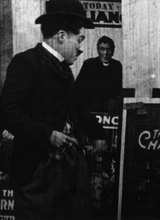
A Film Johnnie
The Tramp visits a nickelodeon and falls in love with the pretty ‘Keystone Girl’ (Virginia Kirtley) he sees on the screen. Physically ejected from the nickelodeon for his unruly behavior, he makes his way to the Keystone studios and causes chaos among the many productions. A local fire causes the Keystone crew to take their cameras on location to film the dramatic event. The Tramp follows along and manages to spoil that film as well. The Tramp’s burning desire to be among the movie crowd is finally extinguished at the film’s conclusion when he is doused with water from the fire brigade’s hose.
Chaplin did not believe the film’s director, George ‘Pop’ Nichols, an improvement over Henry Lehrman. Chaplin remembered Nichols in his autobiography as having ‘but one gag, which was to take the comedian by the neck and bounce him from one scene to another. I tried to suggest subtler business, but he too would not listen. ‘We have no time, no time!’ he would cry. All he wanted was an imitation of Ford Sterling.’ Nevertheless, among the film’s precious moments are Chaplin’s improvisations with a revolver. The Tramp’s use of the gun as a toothpick as well as lighting a cigarette from a pistol shot are the beginnings of his use of comic transposition.
The title of the film is a variation of the term ‘a stage-door Johnny’ (a young man who frequents stage doors seeking the company of actresses or chorus girls). The film shares similarities to The Masquerader, His New Job (1915), and Behind the Screen (1916) in the fascinating glimpses they provide of the atmosphere of early Hollywood film studios. Several Keystone personnel (including Henry Lehrman, Roscoe Arbuckle, and Ford Sterling) appear in A Film Johnnie as themselves.
Finished and shipped: February 11, 1914
Released: March 2, 1914
Scenario: Craig Hutchinson
Producer: Mack Sennett
Director: George Nichols
Length: One reel
By Jeffrey Vance, adapted from his book Chaplin: Genius of the Cinema (New York, 2003) (c) 2009 Roy Export SAS

Tango Tangles
Mack Sennett arranged for his most important comedians—Chaplin, Ford Sterling, Roscoe Arbuckle, and Chester Conklin—to improvise a comedy filmed partly on location at the Venice Dance Hall on Abbott Kinney Pier. The film conveys America’s tango dance craze during the early 1910s. Sterling plays the bandleader, Arbuckle a musician, and Chaplin a drunken patron who all compete for the attention of the hat-check girl (Minta Durfee). Tango Tangles—along with the opening scenes of The Masquerader—provides a precious glimpse of the handsome Chaplin as he looked without comedy makeup and clothes as himself off-screen. Further, Chaplin’s comic bout with Sterling (in his last film with Chaplin) suggests some of the choreography and comic business Chaplin performed as the Inebriate in the Karno sketch Mumming Birds in his encounter with ‘Marconi Ali,’ the Terrible Turk and anticipates the many comic duels in future films such as the bouts Chaplin performs with John Rand in The Pawnshop (1916).
Finished and shipped: February 17, 1914
Released: March 9, 1914
Scenario: Mack Sennett
Producer: Mack Sennett
Director: Mack Sennett
Length: One reel
By Jeffrey Vance, adapted from his book Chaplin: Genius of the Cinema (New York, 2003) (c) 2009 Roy Export SAS
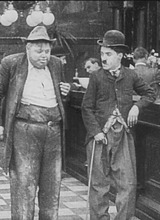
His Favourite Pastime
Charlie’s favorite pastime is drinking at the local tavern. The drunken tramp follows an attractive young lady (Peggy Pearce) to her home where her outraged husband (with whom Charlie has had an altercation earlier at the bar) roughs him up before tossing him out on the street.
Chaplin recalled in his autobiography that Peggy Pearce, who plays the object of the Tramp’s affections in this comedy, was his first serious relationship in Hollywood. It is the only film in which they appear together.
Chaplin used African-American stereotypes/humor less than any of the other great star comedians—Roscoe Arbuckle, Harold Lloyd, Buster Keaton, and Harry Langdon—of the entire silent-film era. Chaplin once said of African-Americans, ‘I never laugh at their humor. They have suffered too much to be funny to me.’ Although one may see an occasional Caucasian in ‘blackface’ in the background of an early Chaplin comedy, it was the custom of the time; there were few African-Americans actors working in Hollywood in 1914. His Favorite Pastime contains the most extensive examples of blackface and humor at the expense of African-Americans in Chaplin’s work at Keystone.
Finished and shipped: February 19, 1914
Released: March 16, 1914
Scenario: Craig Hutchinson
Producer: Mack Sennett
Director: George Nichols
Length: One reel
By Jeffrey Vance, adapted from his book Chaplin: Genius of the Cinema (New York, 2003) (c) 2009 Roy Export SAS
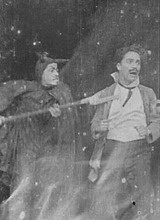
Cruel, Cruel Love
Chaplin, dressed in a top hat and frock coat (similar to his costume in Making a Living) and sporting a large moustache, plays a gentleman of means in this unusual comedy. The gentleman is a happy and attentive lover until his fiancée (Minta Durfee) ends their engagement after she believes she has caught him in a compromising situation with her maid. A despondent Charlie swallows what he believes to be poison. His butler, however, laughs at his lovelorn employer’s agonies as he knows the glass contains only water. Charlie envisions his future of hell tortured by pitchfork-wielding devils and surrounded by fire. When a letter arrives from his fiancée asking his forgiveness and reconciliation, panic replaces his agony as he calls his physicians to save him. A parody D.W. Griffith race to the rescue follows as the film cuts to the two doctors as well as his fiancée rushing to his aid. When the gentleman discovers he has not ingested poison, chaos ensues as Charlie goes on a violent tirade against his butler and the doctors before the reconciled couple embrace at the film’s conclusion.
The sequence in which Chaplin swallows a glass of water believing it is poison and later drinks a glass of milk as an antidote to the poison anticipates a similar sequence in Monsieur Verdoux (1947).
Finished and shipped: March 5, 1914
Released: March 26, 1914
Scenario: Craig Hutchinson
Producer: Mack Sennett
Director: George Nichols
Length: One reel
By Jeffrey Vance, adapted from his book Chaplin: Genius of the Cinema (New York, 2003) (c) 2009 Roy Export SAS

The Star Boarder
Charlie, as the favorite of the landlady (Minta Durfee), enjoys more of her attention than her husband (Edgar Kennedy) and small son (Gordon Griffith). The mischievous boy secretly records various compromising situations with his box camera and creates chaos when he displays them in a magic lantern show to the assembled residents of the boarding house.
The brief, eccentric tennis match between Charlie and his landlady is notable as it records Chaplin’s awareness of the game that would become an off-screen passion beginning in the early 1920s and continuing until a broken ankle and the first of a series of small strokes in 1966 forced him to retire from the sport.
Finished and shipped: March 19, 1914
Released: April 4, 1914
Scenario: Craig Hutchinson
Producer: Mack Sennett
Director: George Nichols
Length: One reel
By Jeffrey Vance, adapted from his book Chaplin: Genius of the Cinema (New York, 2003) (c) 2009 Roy Export SAS
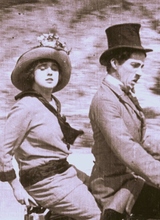
Mabel at the Wheel
Chaplin—costumed in top hat, frock coat, and sporting a goatee—was impersonating the ‘Dutch’ (immigrant German) screen character of Ford Sterling, the former Keystone comedian whom Chaplin was hired to replace. The comedy, the first two-reeler in which he appeared, incorporates footage taken at the Vanderbilt Cup road race in Santa Monica on February 26, 1914. The production was an unhappy one for Chaplin. He was in disagreement with director Mabel Normand—who lacked the approach to comedy he had learned with Karno—and disliked the idea of imitating Sterling. The happy outcome of the experience was the promise Chaplin received from Sennett to allow him to direct future films.
Finished and shipped: March 31, 1914
Released: April 18, 1914
Scenario: Mabel Normand/Mack Sennett
Producer: Mack Sennett
Director: Mabel Normand/Mack Sennett
Length: Two reels
By Jeffrey Vance, adapted from his book Chaplin: Genius of the Cinema (New York, 2003) (c) 2009 Roy Export SAS
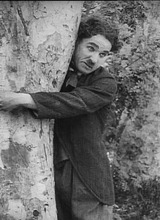
Twenty Minutes of Love
Chaplin’s first tentative effort at both story and direction (whether partial or complete direction is subject to speculation) is a simple park comedy. Chaplin recalled in his autobiography that he made the film in a single afternoon. The Tramp’s first scene is memorable: upon seeing a couple kissing on a park bench, Charlie parodies their ardor by embracing a tree. On another park bench, a woman demands a present as proof of her fiancé’s love. The man (Chester Conklin) steals a watch as his gift. Charlie manages to procure the watch from the pickpocket and presents it to the woman himself. Their flirtation and the ownership of the watch creates pandemonium in the park with everyone but Charlie and the girl ending up in Westlake Park lake.
Chaplin recalled in his autobiography how simple little tunes gave him the image for his comedies. For Twenty Minutes of Love ‘full of cough stuff and nonsense in parks, with policemen and nursemaids, I weaved in and out of situations to the tune of ‘Too Much Mustard,’ a popular two-step [sic] in 1914.’ Chaplin may be referring to story or gags. Chaplin’s claim to both story and direction is supported by the fact that he returned to the same premise the following year with In the Park (1915).
Finished and shipped: March 28, 1914
Released: April 20, 1914
Scenario: Charles Chaplin
Producer: Mack Sennett
Director: Joseph Maddern/Charles Chaplin
Length: One reel
By Jeffrey Vance, adapted from his book Chaplin: Genius of the Cinema (New York, 2003) (c) 2009 Roy Export SAS
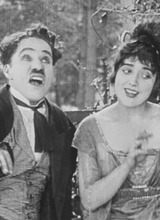
Caught in a Cabaret
Charlie, a café/dancehall waiter, impersonates a foreign dignitary at a garden party in amorous pursuit of a society debutante (Mabel Normand). His true identity is revealed when the society girl and a party of her friends go on a ‘slumming’ expedition at the café where Charlie waits tables. Exposed and spurned, Charlie’s chaotic comeuppance concludes the comedy.
The scenario of this two-reel comedy, and perhaps some of the direction, was shared by Chaplin with Normand. This is one of the few Chaplin comedies that contains pie throwing; a favorite Keystone device. Chaplin would explore in greater depth the comedy’s thematic ideas—particularly class differences and the lowly person aspiring to a higher life—in many of his subsequent films. Situations and themes from this film would be reworked for The Count (1916), The Rink (1916), The Idle Class (1921), and Modern Times (1936) and Chaplin’s use of a canine companion resurfaces in The Champion (1915) and A Dog’s Life (1918).
Finished and shipped: April 11, 1914
Released: April 27, 1914
Scenario: Mabel Normand/Charles Chaplin
Producer: Mack Sennett
Director: Mabel Normand
Length: Two reels
By Jeffrey Vance, adapted from his book Chaplin: Genius of the Cinema (New York, 2003) (c) 2009 Roy Export SAS

Caught in the Rain
Charlie flirts with a married lady (Alice Davenport) in a park, only to be warned off by Ambrose (Mack Swain) her outraged husband. Returning to his hotel after a stop at the local saloon, the drunken Charlie is rebuffed in his pursuit of another attractive young woman. Charlie’s room is opposite that of Ambrose and his wife. The sleepwalking wife enters Charlie’s room. Alarmed rather than delighted, Charlie leads her back to her own room and attempts to return to his own bed without Ambrose’s knowledge. At one point, Charlie seeks refuge on a balcony—only to be ‘caught in the rain’—and is mistaken by some cops as a burglar.
Caught in the Rain is an important work in Chaplin’s career as it is his first film in which scenario and direction were exclusively his own. Chaplin remembered in his autobiography:
When I started directing my first picture, I was not as confident as I thought I would be; in fact, I had a slight attack of panic. But after Sennett saw the first day’s work I was reassured…Caught in the Rain…was not a world-beater, but it was funny and quite a success.
The film draws upon past successes; Caught in the Rain is not an ambitious effort. The comedy begins in a park (a throwback to Twenty Minutes of Love) quickly moves to a bar (the excuse for Chaplin’s sure-fire drunkard), and finishes with a hotel lobby and room mixup (in the manner of Mabel’s Strange Predicament). Chaplin ends the film with the Keystone Cops for good measure. Chaplin revisited similar situations in A Night Out (1915).
Finished and shipped: April 18, 1914
Released: May 4, 1914
Scenario: Charles Chaplin
Producer: Mack Sennett
Director: Charles Chaplin
Length: One reel
By Jeffrey Vance, adapted from his book Chaplin: Genius of the Cinema (New York, 2003) (c) 2009 Roy Export SAS
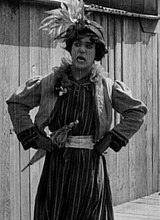
A Busy Day
Chaplin obstructs a camera crew as he did in Kid Auto Races at Venice, Cal. but this time he is dressed as a shrewish woman whom neither her husband (Mack Swain), the film director (Mack Sennett), nor the local cop can control. A Busy Day was filmed in Wilmington on April 11, 1914 during a dedication ceremony and parade celebrating the Los Angeles Harbor expansion.
A split-reel comedy, A Busy Day was originally released with the educational film The Morning Papers.
Finished and shipped: April 18, 1914
Released: May 7, 1914
Scenario: Charles Chaplin
Producer: Mack Sennett
Director: Mack Sennett
Length: Split reel
By Jeffrey Vance, adapted from his book Chaplin: Genius of the Cinema (New York, 2003) (c) 2009 Roy Export SAS

The Fatal Mallet
The Tramp and another man (Mack Sennett) are rivals for the attention of a young woman (Mabel Normand). The competition between the men results in some violent brick hitting and throwing. The two men eventually join forces against another admirer (Mack Swain) with more bricks and a new weapon: a mallet. The comedy concludes with Sennett and Normand walking off together while his rivals having been pushed into a lake.
One of the crudest of the Chaplin-Keystone comedies, it nevertheless fascinates for the extended comic interplay between Chaplin and Sennett. Chaplin revisited monstrous mallets as comic weapons in Laughing Gas, The Tramp (1915), and Police (1916).
Finished and shipped: May 16, 1914
Released: June 1, 1914
Scenario: Mack Sennett
Producer: Mack Sennett
Director: Mack Sennett
Length: One reel
By Jeffrey Vance, adapted from his book Chaplin: Genius of the Cinema (New York, 2003) (c) 2009 Roy Export SAS
Her Friend the Bandit
This is the only Chaplin Keystone comedy that appears to be no longer extant. Chaplin plays the bandit of the film’s title who captures Count De Beans (Charles Murray) and commanders his evening clothes and invitation card to and pose as the aristocrat at an elegant reception held by Mrs. De Rocks (Mabel Normand) home. Charlie enjoys himself tremendously until the Keystone Cops arrive. Moving Picture World wrote in their review of the film that Chaplin and Charles Murray ‘play the chief funny characters of this farce which is a bit thin; but it has the rough whirling of happenings usually found in farces of this well-marked type.’ Chaplin revisited ideas from this comedy in such later films as The Count (1916), The Rink (1916), and The Idle Class (1921).
Finished and shipped: May 22, 1914
Released: June 4, 1914
Scenario: Charles Chaplin
Producer: Mack Sennett
Director: Mack Sennett
Length: One reel
By Jeffrey Vance, adapted from his book Chaplin: Genius of the Cinema (New York, 2003) (c) 2009 Roy Export SAS
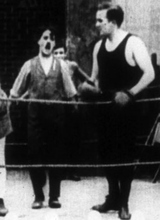
The Knockout
Chaplin appears briefly in the second reel of this Roscoe Arbuckle comedy as the overly zealous boxing referee who manages to be on the receiving end of punches in a bout between Arbuckle and Edgar Kennedy. Chaplin clearly contributed much of his comedy material as it borrows from bits in Karno sketches (Mumming Birds as well as another Karno sketch with which Chaplin was familiar, The Yap Yaps). Chaplin enjoyed boxing matches; he attended prizefights in Los Angeles well into the 1930s and would incorporate boxing scenes in his own films The Champion (1915) and City Lights (1931). The interior mansion set used in this film also appears in the later Tillie’s Punctured Romance.
Finished and shipped: May 29, 1914
Released: June 11, 1914
Scenario: Unknown
Producer: Mack Sennett
Director: Mack Sennett
Length: Two reels
By Jeffrey Vance, adapted from his book Chaplin: Genius of the Cinema (New York, 2003) (c) 2009 Roy Export SAS

Mabel's Busy Day
Mabel (Mabel Normand) is a hot dog vendor who, like a shabby scoundrel (Chaplin), has to trick her way into entry at the racetrack. Chaplin wears his usual moustache and big boots but sports a light-colored derby and frock coat as a comic villain. Charlie pesters several women while Mabel has trouble peddling her hot dogs. Charlie swipes one of her hot dogs—and later her entire franchise—before the film ends with the two consoling each other at the end of a busy, if not profitable, day at the racetrack. A nominal effort, Mabel’s Busy Day was filmed on location at the Ascot Park Speedway in Los Angeles at a special exhibition race on May 17, 1914. The bystanders in certain scenes, gathered for the race, afford the viewer precious glimpses of how the general public reacted to Chaplin’s antics.
Finished and shipped: May 30, 1914
Released: June 13, 1914
Scenario: Unknown
Producer: Mack Sennett
Director: Mack Sennett
Length: One reel
By Jeffrey Vance, adapted from his book Chaplin: Genius of the Cinema (New York, 2003) (c) 2009 Roy Export SAS

Mabel's Married Life
Mabel and her husband (Chaplin) visit a park where she is subjected to the unwanted flirtations of a cad (Mack Swain). Charlie’s unsuccessful efforts to stop the cad later inspire Mabel to buy a boxing dummy in the hopes that the dummy will make a man out of her ineffectual spouse. Her drunken husband returns home and mistakes the dummy for the cad they encountered at the park and spars with the ‘intruder.’ Mabel finally manages to convince her inebriated husband that his adversary is only a dummy.
Mabel’s Married Life is one of several Keystone comedies in which Chaplin (wearing a top hat instead of his usual derby) appears as a married man. He plays a husband in the subsequent Keystone films The Rounders, His Trysting Places, and Getting Acquainted and is married during the course of Tillie’s Punctured Romance. Chaplin subsequently portrayed a married man with two small sons in A Day’s Pleasure (1919) and a henpecked husband in Pay Day (1922).
Mabel’s Married Life is one of several Chaplin Keystone comedies that prominently features Echo Park Lake, just five blocks south of the Keystone Studios, in Echo Park. The lake and distinctive Echo Park Bridge are still enjoyed and remain essentially the same in the twenty-first century.
Finished and shipped: June 6, 1914 Released: June 20, 1914 Scenario: Charles Chaplin/ Mabel Normand Producer: Mack Sennett. Director: Mack Sennett Length: One reel
By Jeffrey Vance, adapted from his book Chaplin: Genius of the Cinema (New York, 2003) (c) 2009 Roy Export SAS
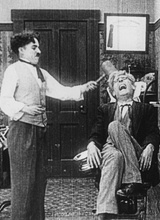
Laughing Gas
Charlie is a dentist’s assistant who blunders his tasks and abuses patients before he makes additional enemies at a nearby pharmacy. Upon his return to the dental office, he substitutes for the absent ‘Dr. Pain’ for a time before a comic mêlée brings the film to its conclusion.
The film owes some of its inspiration to a Fred Karno sketch Chaplin was familiar with but never performed during his career, The Dentist, although dentistry and tooth extraction have been a source of humor since the commedia dell’arte. Chaplin loathed dentists and dentistry and his family have many memories of the difficulties in getting him to tolerate even infrequent visits to a dentist in his later years. Chaplin makes disparaging comments about dentistry in the role of King Shahdov in his penultimate film, A King in New York (1957).
Chaplin’s aggressive mischief dominates the comedy, although the film’s most charming moments involve his gentle flirtations with a pretty female patient; Charlie uses the dentist’s forceps to hold her nose and appropriate a few kisses from her.
Finished and shipped: June 26, 1914
Released: July 9, 1914
Scenario: Charles Chaplin
Producer: Mack Sennett
Director: Charles Chaplin
Length: One reel
By Jeffrey Vance, adapted from his book Chaplin: Genius of the Cinema (New York, 2003) (c) 2009 Roy Export SAS

The Property Man
Charlie is a property man in a vaudeville theater who must contend with the many demands of the various acts—the comediennes ‘The Goo-Goo Sisters,’ the strongman ‘Garlico,’ and the dramatic sketch artistes ‘George Ham and Lena Fat.’ Rehearsal goes poorly as does the first performance and the film ends with Charlie ending an argument by turning on the fire hose and deluging the entire company and the audience.
Chaplin’s first two-reel comedy as director/scenarist/star once again draws upon the Karno sketch Mumming Birds as a source of inspiration (especially the burlesque of terrible stage acts). The Property Man was Chaplin’s first film set in a vaudeville theater/music hall. He would subsequently return to the theatrical world with the films A Night in the Show (1915), A Dog’s Life (1918), and Limelight (1952).
Despite the many elements of crudeness and cruelty in the Chaplin Keystone comedies, commentators throughout the years have cited The Property Man as being especially cruel. The first critical complaint was expressed by Moving Picture World in their review of the film, ‘There is some brutality in this picture and we can’t help feeling this is reprehensible. What human being can see an old man kicked in the face and count it fun?’ Evidently Charlie’s treatment of the elderly assistant property man as well as Garlico’s treatment of Charlie hit a nerve with some audiences, despite the broad caricature of the clowning—and the resilience of the clowns themselves—that Chaplin employs in this comedy.
Finished and shipped: July 20, 1914
Released: August 1, 1914
Scenario: Charles Chaplin
Producer: Mack Sennett
Director: Charles Chaplin
Length: Two reels
By Jeffrey Vance, adapted from his book Chaplin: Genius of the Cinema (New York, 2003) (c) 2009 Roy Export SAS

The Face on the Bar Room Floor
Chaplin parodies the ballad form poem ‘The Face Upon the Floor’ by Hugh Antoine d’Arcy of the once prosperous painter who, having lost his beloved Madeleine (Cecile Arnold) to another man, becomes destitute in despair and is reduced to drawing her ‘face on the bar room floor.’ Charlie, as the heartbroken and inebriated artist, tells his tale of woe in a tavern as a series of flashbacks. The rendering of his beloved he produces at the film’s conclusion is such an amateurishly bad line drawing that it prompts the patrons of the bar to boot him out onto the street.
One of the least interesting of the Chaplin Keystones in terms of entertainment value, it is nonetheless a valuable artifact as one of Hollywood’s early parodies of a literary work. The film’s flashback storytelling technique is uncommon for Chaplin; he used it in only two subsequent films: Shoulder Arms (1918) and Limelight (1952).
Finished and shipped: July 20, 1914
Released: August 10, 1914
Scenario: Charles Chaplin
Producer: Mack Sennett
Director: Charles Chaplin
Length: One reel
By Jeffrey Vance, adapted from his book Chaplin: Genius of the Cinema (New York, 2003) (c) 2009 Roy Export SAS

Recreation
A park comedy, filmed in one day, involves the Tramp, his encounters with a pretty young woman, her sailor boyfriend, and cops with everyone landing in a lake.
A split reel comedy, Recreation was originally released with the educational film The Yosemite.
Finished and shipped: July 21, 1914
Released: August 13, 1914
Scenario: Charles Chaplin
Producer: Mack Sennett
Director: Charles Chaplin
Length: Split reel
By Jeffrey Vance, adapted from his book Chaplin: Genius of the Cinema (New York, 2003) (c) 2009 Roy Export SAS
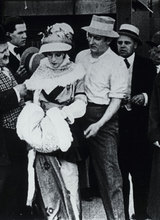
The Masquerader
Chaplin plays a mischievous version of himself in this splendid comedy. He is first seen in his civilian clothes—and without comedy makeup—entering the Keystone studios. Once he has put on his familiar comedy makeup and Tramp costume, he flirts with two attractive ladies, misses his cue, and twice ruins the scene being filmed. He is eventually replaced and ultimately fired by the director. The crafty Charlie reenters the studio disguised as a charming young woman and is hired at once as a leading lady. Charlie quickly reverts back to his familiar comedy makeup and clothes, reveals his imposture, and is chased about the studio. The film ends with Charlie, having retreated into the studio well, submerged in water and defeated in his masquerade.
The Masquerader is the second of three comedies in which Chaplin appears as a woman; the earlier A Busy Day has Chaplin in crude drag playing a shrewish wife; the later A Woman (1915) further develops what he achieved in this comedy: a brilliant transformation to a soft, feminine, and seductive woman. The Masquerader is also one of several Chaplin comedies, like the earlier A Film Johnnie and the later His New Job (1915) and Behind the Screen (1916), set in a motion picture studio.
Finished and shipped: August 12, 1914
Released: August 27, 1914
Scenario: Charles Chaplin
Producer: Mack Sennett
Director: Charles Chaplin
Length: One reel
By Jeffrey Vance, adapted from his book Chaplin: Genius of the Cinema (New York, 2003) (c) 2009 Roy Export SAS
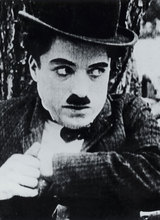
His New Profession
A young man (Charles Parrott who would achieve great fame as a comedian as Charley Chase) hires Charlie to care for his wheelchair bound uncle while he spends time with his girlfriend. Charlie places a ‘help a cripple’ sign on the sleeping man in order to make some quick change to buy a drink. He abandons his charge with the first donation and enters the pier bar. A drunken Charlie returns to his work with even less enthusiasm than he had before; the gouty foot uncle nearly rolls of the pier twice. Charlie flirts with the nephew’s girlfriend and the comedy climaxes with a melee involving Charlie, the nephew, his girlfriend, and a couple of cops and concludes with Charlie stealing off with the nephew’s girl.
Filmed on location in Venice and Ocean Park, California, His New Profession anticipates Charlie’s treatment of gout-ridden Eric Campbell in The Cure (1917) and indicates Chaplin’s early interest in the National Police Gazette—a notorious tabloid with crime, sport, theater, and sin in general as favorite topics and illustrated with fine woodcut drawings—which reappears as favorite reading material in The Kid (1921) and is referenced in Limelight (1952).
Finished and shipped: August 14, 1914
Released: August 31, 1914
Scenario: Charles Chaplin
Producer: Mack Sennett
Director: Charles Chaplin
Length: One reel
By Jeffrey Vance, adapted from his book Chaplin: Genius of the Cinema (New York, 2003) (c) 2009 Roy Export SAS

The Rounders
‘Rounder,’ is an archaic term meaning a drunk (believed to derive from ‘rounds’ of drinks), although the somewhat obsolete meaning of a dissolute person might as easily describe the two main characters of this superb comedy. Mr. Full (Chaplin) and Mr. Fuller (Roscoe Arbuckle) are a couple of disgraceful drunks making their rounds at home and to a café pursued by their angry spouses. They eventually flee to a park and to a rowboat, sinking to the bottom on Echo Park Lake.
This comedy is the only teaming of Chaplin and Arbuckle; their other six appearances—A Film Johnnie, Tango Tangles, His Favorite Pastime, The Knockout, The Masquerader, and His New Profession—did not afford much comic interplay. Arbuckle later paid tribute to Chaplin with the comment ‘I have always regretted not having been his partner in a longer film than these one-reelers we made so rapidly. He is a complete comic genius, undoubtedly the only one of our time and he will be the only one who will be still talked about a century from now.’
The best of Chaplin’s drunk roles for Keystone, The Rounders anticipates his comic teaming with Ben Turpin in A Night Out (1915) and Harry Myers in City Lights (1931).
Finished and shipped: August 21, 1914
Released: September 7, 1914
Scenario: Charles Chaplin
Producer: Mack Sennett
Director: Charles Chaplin/Roscoe Arbuckle
Length: One reel
By Jeffrey Vance, adapted from his book Chaplin: Genius of the Cinema (New York, 2003) (c) 2009 Roy Export SAS
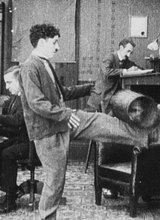
The New Janitor
Charlie is a janitor in an office building who blunders his tasks and eventually fired. As he is about to leave, the stenographer rings for help. He returns to stop a robbery; saving the pretty stenographer and capturing the thieving office employee. Charlie the hero is rewarded and all ends well.
The New Janitor is one of Chaplin’s most finely crafted and important works for Keystone. In most of the Keystone comedies Chaplin directed, one can glimpse his experimenting with film technique. The New Janitor demonstrates a marked progression in narrative and the emergence of his use of sentiment with comedy. He would expand and remake The New Janitor as The Bank (1915) the following year.
In addition to his use of sentiment, Chaplin employs “thrill” comedy (Charlie on the edge of the window sill and in one shot hanging out of the Marsh-Strong Building at 9th and Main in Los Angeles) a couple of years before “high and dizzy” became popular in film comedy. However, whereas Chaplin pioneered the use of comedy and sentiment in slapstick comedy, he only returned to “thrill” comedy sequences in The Gold Rush (1925) and The Circus (1928) as the result of the popular use of “thrill” comedy in the films of Harold Lloyd.
Finished and shipped: September 3, 1914
Released: September 24, 1914
Scenario: Charles Chaplin
Producer: Mack Sennett
Director: Charles Chaplin
Length: One reel
By Jeffrey Vance, adapted from his book Chaplin: Genius of the Cinema (New York, 2003) (c) 2009 Roy Export SAS

Those Love Pangs
Charlie and Chester Conklin are rivals in the attention of any woman they happen to see together, whether it be their landlady or an attractive woman at the local park. Disheartened by his failure with women, Charlie attempts suicide by jumping into a lake; a cop prevents him and he quickly galvanizes himself into action in his sexual rivalry with Chester. Chester, enjoying the attention of two ladies, is knocked cold by Charlie and follows the two women (who give the suggestion of being prostitutes) to a nickelodeon. Charlie enjoys himself seated between the two women, but Chester and another man send him flying through the movie screen.
According to Mack Sennett, Chaplin began Those Love Pangs with little more than the idea of the on-screen rivalry of Charlie and Chester in pursuit of their landlady. Chaplin developed the idea of the two men working at a café/bakery. This suggested so much fine comedy material it grew into the two-reel comedy Dough and Dynamite, leaving Those Love Pangs as a poor deviation of A Star Boarder, a park comedy similar to Twenty Minutes of Love, and ending with the nickelodeon sequence with the flavor of A Film Johnnie. Nevertheless, Chaplin’s performance touches make the film notable. He uses his walking stick as an extension of himself (the hook of the cane pulls Chester along and sends a man into a lake.) Chaplin also transforms the bamboo cane to both clean his nails and serve as toothpick. Chaplin makes an art of drop-kicking a cigarette with the bottom of his boot at Keystone; an excellent example appears in this film. Best of all is how Charlie at the nickelodeon—his arms around the two women—uses his feet to further flirt with animated ecstasy.
Finished and shipped: September 19, 1914
Released: October 10, 1914
Scenario: Charles Chaplin
Producer: Mack Sennett
Director: Charles Chaplin
Length: One reel
By Jeffrey Vance, adapted from his book Chaplin: Genius of the Cinema (New York, 2003) (c) 2009 Roy Export SAS
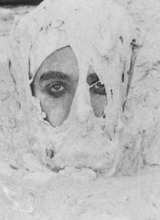
Dough and Dynamite
Dough and Dynamite is perhaps the most important comedy Chaplin made in his early ascent to screen stardom and the most profitable of all the Keystone two-reel comedies. According to Chaplin, the film, which required nine days of production and ran $800.over the $1,000 budget, grossed more than $130,000 during its first year in distribution. In the early silent-film era, Dough and Dynamite was generally regarded as one of the greatest of all Hollywood comedies.
Chaplin and Chester Conklin play waiters at a café/bakery who are forced by their ill-tempered employer to man the ovens when the bakers go on strike. The strikers secretly place a stick of dynamite in a loaf of bread that Charlie unwittingly places in the oven. The explosion of the café/bakery concludes the film, with everyone dazed and confused among the rubble. The last shot is a close-up of Charlie struggling out from under an enormous layer of dough.
More than just a successful comedy, Dough and Dynamite references then-current labor issues in Los Angeles involving the city’s bakers’s unions demands for better working conditions. The film’s final shot, Charlie emerging from the gooey dough, anticipates the conclusion of Work (1915). Angry strikers reappear in Behind the Screen (1916) and Modern Times (1936).
Finished and shipped: September 18, 1914
Released: October 26, 1914
Scenario: Charles Chaplin
Producer: Mack Sennett
Director: Charles Chaplin
Length: Two reels
By Jeffrey Vance, adapted from his book Chaplin: Genius of the Cinema (New York, 2003) (c) 2009 Roy Export SAS

Gentleman of Nerve
Chaplin plays Mr. Wow Wow (Chaplin again draws on a Karno sketch, The Wow-Wows, for inspiration) described as “a disturbing influence,” in this slight one reel event comedy filmed partly at Ascot Park speedway (like the earlier Mabel’s Busy Day) on September 20, 1914 to take advantage of the Bert Dingley special exhibition benefit race. The film’s most delightful sequence involves Mr. Wow Wow sitting next to an attractive young woman and stealing sips—through a drinking straw—from her soda bottle. Chaplin later reworked this situation for the lunch break sequence in Behind the Screen (1916).
Finished and shipped: October 7, 1914
Released: October 29, 1914
Scenario: Charles Chaplin
Producer: Mack Sennett
Director: Charles Chaplin
Length: One reel
By Jeffrey Vance, adapted from his book Chaplin: Genius of the Cinema (New York, 2003) (c) 2009 Roy Export SAS
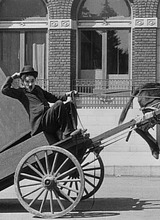
His Musical Career
Charlie is hired as an assistant piano mover. Instructed to deliver a piano to 666 Prospect Street and to repossess one from 999 Prospect Street, the piano mover (Mack Swain) and his new helper set off in their donkey cart and muddle their assignment by doing the opposite. The film concludes with the slide of the piano down a steep road and sinking into a nearby lake.
Charles Parrott plays the owner of the piano store; one of many small parts Parrott played in Chaplin’s Keystone comedies before achieving great fame as a comedian as Charley Chase for pioneering comedy producer Hal Roach. Another notable Roach connection is that Chaplin’s comedy served as a precursor—if not the prototype—to the Laurel and Hardy three-reel comedy The Music Box (1932), produced by Hal Roach and directed by James Parrott (younger brother of Charles), which won the first Academy Award for best short subject (comedy).
Beyond his appearances with Chaplin in the Keystone comedies, Mack Swain later appeared in Chaplin’s The Idle Class (1921), Pay Day (1922), The Pilgrim (1923), and as Big Jim McKay in The Gold Rush (1925), his best-remembered role of his entire career.
Finished and shipped: October 17, 1914
Released: November 7, 1914
Scenario: Charles Chaplin
Producer: Mack Sennett
Director: Charles Chaplin
Length: One reel
By Jeffrey Vance, adapted from his book Chaplin: Genius of the Cinema (New York, 2003) (c) 2009 Roy Export SAS
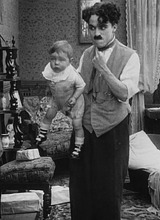
His Trysting Place
The domestic discord of Charlie and his wife (Mabel Normand) stands in stark contrast to the harmonious Ambrose (Mack Swain) and his wife (Phyllis Allen). The two men meet and, after an altercation in a restaurant, mistakenly take each other’s overcoat. Mabel finds a love letter in Ambrose’s coat pocket; she thinks her husband has a mistress. Ambrose’s wife finds a baby bottle in Charlie’s coat pocket; she suspects her husband has an illegitimate child. The mix-up continues in a local park, with Charlie and Mabel eventually reconciled but with Ambrose still in hot water with his wife.
His Trysting Places is one of the better two-reelers Chaplin made for Keystone in terms of story structure, directing, and editing. However, Chaplin’s frequently cruel screen characterization is far removed from his Little Tramp of such later masterpieces as The Kid (1921) and that film’s tender and loving relationship between parent and child. In His Trysting Places, Charlie holds Peter, his young son, by the scruff of his rompers, allows him to play with a genuine handgun on the floor, and indifferently places him near a dangerously fiery stove. As Mack Sennett noted in his autobiography, Chaplin “preceded W.C. Fields by many years with scenes in which he got laughs by being mean to a baby.” The indifference with which he treats his young son in this comedy anticipates Charlie, the policeman, in Easy Street (1917), who feeds an impoverished family’s brood of children like chickens as well as the brat kid of The Pilgrim (1923), whom Charlie gives a well-earned kick.
Finished and shipped: October 1, 1914
Released: November 9, 1914
Scenario: Charles Chaplin
Producer: Mack Sennett
Director: Charles Chaplin
Length: Two reels
By Jeffrey Vance, adapted from his book Chaplin: Genius of the Cinema (New York, 2003) (c) 2009 Roy Export SAS
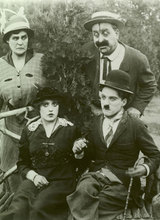
Getting Acquainted
Charlie and Mabel escape their spouses (Phyllis Allen and Mack Swain) to flirt in a park in this one-reel comedy. His final effort for Keystone, Getting Acquainted was filmed in Westlake Park in one day. Despite its similarity to earlier park comedies, it is nonetheless better structured and directed than Chaplin’s previous efforts set in a park and avoids such devices as brick throwing, pie throwing, or a finale with everyone falling into the lake.
Finished and shipped: November 22, 1914
Released: December 5, 1914
Scenario: Charles Chaplin
Producer: Mack Sennett
Director: Charles Chaplin
Length: One reel
By Jeffrey Vance, adapted from his book Chaplin: Genius of the Cinema (New York, 2003) (c) 2009 Roy Export SAS
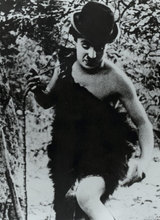
His Prehistoric Past
The finding of the so-called “Piltdown Man” in 1912 (the supposed remains of a hitherto unknown early human later revealed to be a paleontological hoax) and other prehistoric discoveries of the period created an enormous interest in human ancestry with the general public. Man’s Genesis (1912), a one-reel drama directed by D.W. Griffith for Biograph, is an example of this and soon it became fodder for comic films.
Chaplin structured His Prehistoric Past, his last two-reel comedy for Keystone, with the dream-fantasy device of the Karno sketch Jimmy the Fearless. The Tramp falls asleep on a park bench and dreams he is a caveman. Chaplin recalled in his autobiography:
In His Prehistoric Past, I started with one gag, which was my first entrance. I appeared dressed as a prehistoric man wearing a bearskin, and, as I scanned the landscape, I began pulling the hair from the bearskin to fill my pipe. This was enough of an idea to stimulate a prehistoric story, introducing love, rivalry, combat and chase. This was the method by which we all worked at Keystone.
The Tramp’s exploits are brought to an abrupt end by a policeman (played by Sydney Chaplin, Chaplin’s elder half brother) who forcibly orders him off the park bench and sends him on his way.
Chaplin revisited dream sequences—with rude awakenings—in The Bank (1915), Shoulder Arms (1918), Sunnyside (1919), The Kid (1921), The Idle Class (1921), The Gold Rush (1925), Modern Times (1936), and Limelight (1952).
Finished and shipped: October 31, 1914
Released: December 7, 1914
Scenario: Charles Chaplin
Producer: Mack Sennett
Director: Charles Chaplin
Length: Two reels
By Jeffrey Vance, adapted from his book Chaplin: Genius of the Cinema (New York, 2003) (c) 2009 Roy Export SAS

Tillie's Punctured Romance
Hollywood’s first feature-length slapstick comedy, Tillie’s Punctured Romance was a vehicle for stage star Marie Dressler, and the character of Tillie was based on the 1909 musical play Tillie’s Nightmare by Edgar Smith, with music by A. Baldwin Sloane, which Dressler had made into a Broadway hit.
Dressler was signed to a twelve-week contract that guaranteed her a weekly salary of $2,500. Filming was accomplished in approximately 45 working days over eight weeks, April 14, 1914 June 9, 1914 (with postproduction the film required fourteen weeks to complete), at a cost of $50,000. It was a complicated production for producer-director Mack Sennett. He later recalled that in addition to making the feature film, “I had to continue the steady flow of short comedies each week. This meant that I never had my Tillie cast all working together on any given day. One or two of them were constantly out of the picture acting in a two-reeler.” Indeed, Chaplin was to make five comedies during the production of Tillie’s Punctured Romance: The Fatal Mallet, The Knockout, Her Friend the Bandit, Mabel’s Busy Day, and Mabel’s Married Life.
The film’s simple story involves Tillie Banks (Marie Dressler), a country girl deceived by a city slicker (Chaplin) to steal her father’s money and run away with him to the city. Once there, the slicker takes her money and abandons her for Mabel (Mabel Normand). When it is reported that Tillie is the sole heir to a fortune, the slicker finds Tillie, marries her, and enjoys the good life until the fortune Tillie has inherited proves to be short-lived A chase ensues when Tillie finds the slicker in a compromising moment with Mabel.
Despite Chaplin having only a supporting role in the production, Tillie’s Punctured Romance benefited him more than anyone else when the film was first shown at a trade show in November 1914; nearly every motion-picture producer pursued him, wanting to sign him to a contract. Tillie’s Punctured Romance was a tremendous popular success when released, and Chaplin was singled out for his considerable work in making the film a hit. Moving Picture World wrote, “ Chaplin outdoes Chaplin; that’s all there is to it. His marvelous right-footed skid…is just as funny in the last reel as it is in the first” and Variety noted, “Miss Dressler is the central figure, but Chaplin’s camera antics are an essential feature in putting the picture over.” Chaplin, however, did not think much of the film. In his autobiography he dismissed it: “It was pleasant working with Marie, but I did not think the picture had much merit.”
The Mutual Film Corporation was not equipped to distribute feature films so this was the only Chaplin film made at Keystone that was distributed by the newly-formed Alco Film Corporation. Tillie’s Punctured Romance was in constant theatrical distribution—continually abridged and later with music and sound effects added—well into the 1940s.
Finished and shipped: December 4, 1914
Premiere: December 21, 1914 at the Republic Theater, Los Angeles
Scenario: Mack Sennett
Producer: Mack Sennett
Director: Mack Sennett
Length: Six reels
By Jeffrey Vance, adapted from his book Chaplin: Genius of the Cinema (New York, 2003) (c) 2009 Roy Export SAS